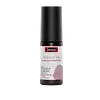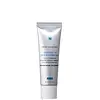What's inside
What's inside
 Key Ingredients
Key Ingredients

 Benefits
Benefits

 Concerns
Concerns

 Ingredients Side-by-side
Ingredients Side-by-side

Water
Skin ConditioningGlycolic Acid
BufferingDimethicone
EmollientPropanediol
SolventSodium Hydroxide
BufferingDecyl Glucoside
CleansingSaccharide Isomerate
HumectantPanthenol
Skin ConditioningHydroxyethylcellulose
Emulsion StabilisingBenzyl Alcohol
PerfumingEthylhexylglycerin
Skin ConditioningSodium Hyaluronate
HumectantCitric Acid
BufferingSodium Citrate
BufferingHydrolyzed Sodium Hyaluronate
Skin ConditioningLinalool
PerfumingGeraniol
PerfumingLimonene
PerfumingAmyl Cinnamal
PerfumingWater
Skin ConditioningGlycolic Acid
BufferingDicaprylyl Carbonate
EmollientDimethicone
EmollientSodium Hydroxide
BufferingButylene Glycol
HumectantPropanediol
SolventGlycerin
HumectantPhytic Acid
Cetyl PEG/PPG-10/1 Dimethicone
EmulsifyingAluminum Starch Octenylsuccinate
AbsorbentNylon-12
Polyglyceryl-4 Isostearate
EmulsifyingMagnesium Sulfate
Jojoba Esters
EmollientPhenoxyethanol
PreservativeHelianthus Annuus Seed Cera
EmollientCaprylyl Glycol
EmollientDisodium EDTA
Salicylic Acid
MaskingAcacia Decurrens Flower Cera
EmollientPolyglycerin-3
HumectantTocopherol
AntioxidantPentaerythrityl Tetra-Di-T-Butyl Hydroxyhydrocinnamate
AntioxidantWater, Glycolic Acid, Dicaprylyl Carbonate, Dimethicone, Sodium Hydroxide, Butylene Glycol, Propanediol, Glycerin, Phytic Acid, Cetyl PEG/PPG-10/1 Dimethicone, Aluminum Starch Octenylsuccinate, Nylon-12, Polyglyceryl-4 Isostearate, Magnesium Sulfate, Jojoba Esters, Phenoxyethanol, Helianthus Annuus Seed Cera, Caprylyl Glycol, Disodium EDTA, Salicylic Acid, Acacia Decurrens Flower Cera, Polyglycerin-3, Tocopherol, Pentaerythrityl Tetra-Di-T-Butyl Hydroxyhydrocinnamate
 Reviews
Reviews

Ingredients Explained
These ingredients are found in both products.
Ingredients higher up in an ingredient list are typically present in a larger amount.
Dimethicone is a type of synthetic silicone created from natural materials such as quartz.
What it does:
Dimethicone comes in different viscosities:
Depending on the viscosity, dimethicone has different properties.
Ingredients lists don't always show which type is used, so we recommend reaching out to the brand if you have questions about the viscosity.
This ingredient is unlikely to cause irritation because it does not get absorbed into skin. However, people with silicone allergies should be careful about using this ingredient.
Note: Dimethicone may contribute to pilling. This is because it is not oil or water soluble, so pilling may occur when layered with products. When mixed with heavy oils in a formula, the outcome is also quite greasy.
Learn more about DimethiconeGlycolic Acid is arguably the most famous alpha hydroxy acid (AHA) with tons of research backing its benefits.
It is found naturally in sugar cane but the form used in skincare is usually synthetic for purity and stability.
Glycolic acid removes the top layer of dead skin cells to allow newer and fresher ones to emerge.
AHAs work by breaking down the structural “glue” that holds old skin cells in place. When that buildup is gone, your skin can renew itself more efficiently.
Research also shows glycolic acid stimulates collagen production, helping to firm and thicken the skin over time. This is one of its biggest advantages over other AHAs.
Overall, glycolic acid helps with:
Fun fact: Glycolic acid boosts skin hydration by helping it produce molecules that increase hyaluronic acid naturally.
To work best, glycolic acid products should have a pH between 3-4 (that’s where exfoliation is most effective but still gentle on skin).
The pH and concentration of a product are key to its effectiveness:
It is normal to feel a slight stinging sensation when using glycolic acid. This usually fades as your skin adjusts.
Because glycolic acid has the smallest molecular size in the AHA family, it can penetrate deeper, which enhances its effectiveness but also makes it more likely to irritate sensitive skin.
If your skin is very sensitive or prone to rosacea, glycolic acid may be too strong; in that case, try milder options like lactic acid or a PHA instead.
Recent studies suggest glycolic acid might even help protect against UV damage. But don’t skip sunscreen! Freshly exfoliated skin is more sensitive to the sun.
Glycolic acid is a skincare superstar. It smooths, brightens, hydrates, and firms the skin. Unless you’re highly sensitive, it’s well worth adding to your routine.
Read more about some other popular AHA's here:
Learn more about Glycolic AcidPropanediol is an all-star ingredient. It softens, hydrates, and smooths the skin.
It’s often used to:
Propanediol is not likely to cause sensitivity and considered safe to use. It is derived from corn or petroleum with a clear color and no scent.
Learn more about PropanediolSodium Hydroxide is also known as lye or caustic soda. It is used to adjust the pH of products; many ingredients require a specific pH to be effective.
In small amounts, sodium hydroxide is considered safe to use. However, large amounts may cause chemical burns due to its high alkaline.
Your skin has a natural pH and acid mantle. This acid mantle helps prevent harmful bacteria from breaking through. The acid mantle also helps keep your skin hydrated.
"Alkaline" refers to a high pH level. A low pH level would be considered acidic.
Learn more about Sodium HydroxideWater. It's the most common cosmetic ingredient of all. You'll usually see it at the top of ingredient lists, meaning that it makes up the largest part of the product.
So why is it so popular? Water most often acts as a solvent - this means that it helps dissolve other ingredients into the formulation.
You'll also recognize water as that liquid we all need to stay alive. If you see this, drink a glass of water. Stay hydrated!
Learn more about Water